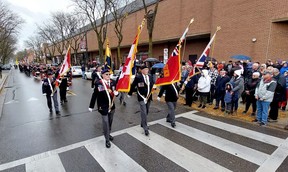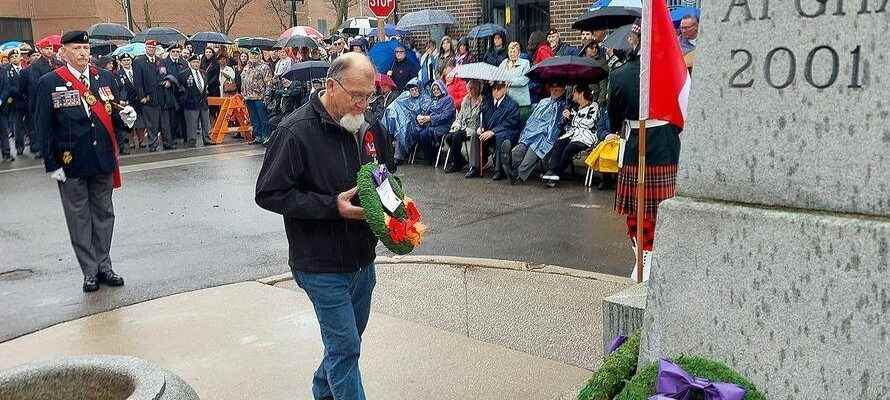The construction of the cenotaph in downtown Chatham nearly a century ago was part of a nationwide desire to remember those who did not return from the First World War.

The construction of the cenotaph in downtown Chatham nearly a century ago was part of a nationwide aspiration to remember those who did not return from the First World War.
For Dan Brant, the impressive monument is a place of comfort he comes to on Remembrance Day to remember and honor the memory of his daughter, Master Corp. Kristal Giesebrecht, one of 165 Canadians, including seven civilians, killed during the war in Afghanistan.
Giesebrecht, a Wallaceburg native, was killed on June 26, 2010, when her armored vehicle detonated an improvised explosive device. She had been serving a second tour of duty as a medic in Afghanistan.
“To me, personally, it means my world,” Brant said of the cenotaph’s significance to him. “It’s what I look forward to come to every year now because I’ve lost my loved one.
“Without it, the hurt would only be that much greater.”
Judging by the hundreds of people who regularly attend the ceremony at the cenotaph, Brant said the support for remembrance seems to be growing “tremendously.”
“People understand more today of what it’s about and they’re not forgetting,” he said. “That’s so good to my heart. It makes me feel good.”
Before the Remembrance Day ceremony began, Tom Mountain, chairman of the outdoor ceremony organized by the Royal Canadian Branch 642 Legion, provided a history lesson about the cenotaph.
Noting Remembrance Day came “from the misery of the First World War,” Mountain said, “Canada contributed greatly to the cause, but the nation was traumatized. Everyone was affected by it in some way.”
After the First World War, he said there was a desire to remember those who did not return.
Until 1970, the bodies of Canadian military personnel who died overseas remained there, Mountain said, so the cenotaph became a “memorial for the people that don’t have a grave in Canada.”

Mountain said the first ceremony of remembrance in Chatham was organized by the chamber of commerce on Dominion Day, July 1, 1919, in Tecumseh Park.
In the fall of that year, King George V requested all activities in the British Commonwealth cease at the 11th hour of the 11th day of the 11th month in recognition of the armistice signed the previous year.
“There was no singular commemorative ceremony, but the veterans and (Imperial Order Daughters of the Empire) organized small events throughout Chatham in schools, clubrooms, churches and even at the mausoleum in Maple Leaf Cemetery,” Mountain said.
In 1923, veterans and members of the Imperial Order of the Daughters of the Empire raised a large sum of money “to erect a magnificent cenotaph to remember the sacrifice of the Great War,” Mountain added
The Chatham cenotaph, which rivals many others in larger cities, also has the Second World War, Korean War and War in Afghanistan represented on the monument to remember the many lives lost.

“These wars were in faraway places and, on the home front, we were spared the horrors of conflict,” Mountain said.
But, he noted, the War of 1812 is a reminder that military conflict can come to Chatham.
The Chatham cenotaph, he said, is located where roughly 1,000 Kentucky militia members stood at the only remaining bridge over McGregor Creek on Oct. 4, 1812. Two hours behind them were another 2,000 American troops advancing on Chatham, he added.
On the other side of McGregor Creek were 200 Indigenous warriors “led by the Great Chief Tecumseh” who were supported by the Caldwell Rangers from Essex and a few Kent militia.
Across the Thames River, there were only about 35 British troops providing “some covering fire,” he added.
He described the battle as a delaying action to provide more time for the British to escape.
“It lasted about two hours and ended when the Americans brought in their cannon,” he said. “People died here and many were injured. Tecumseh himself was wounded here and was killed the next day in the Battle of the Thames.”
He said the populations on farms and in settlements, as well as nearby First Nation communities, suffered greatly in those times and took many years to recover.
“Our cenotaph is one of the few that actually sits on a battlefield,” Mountain said.
